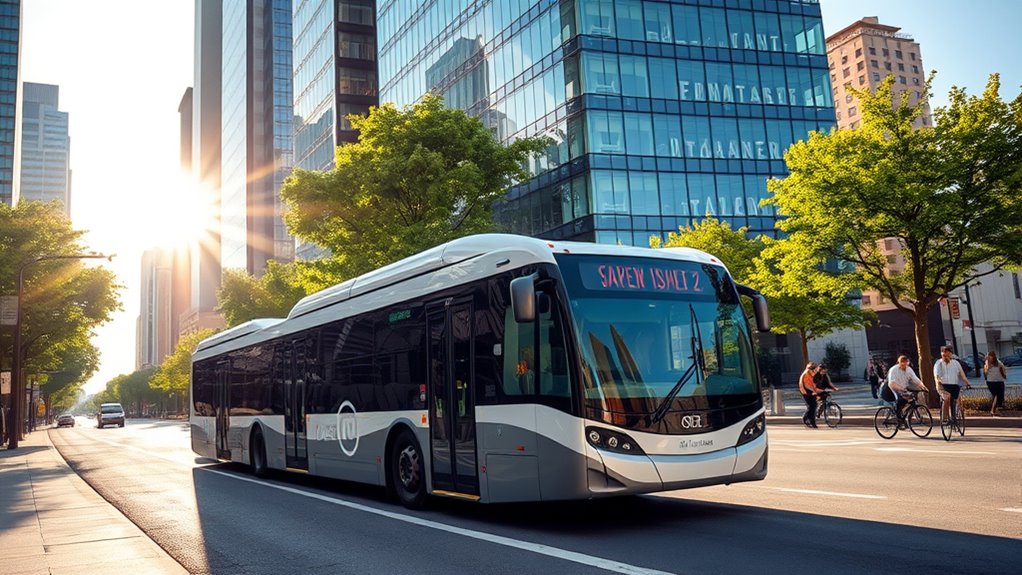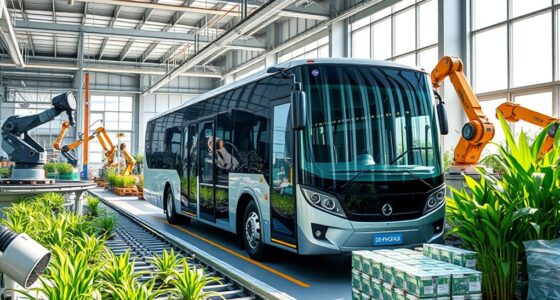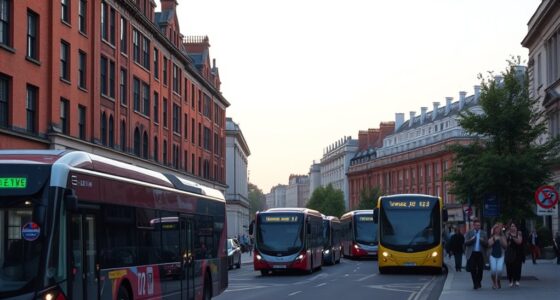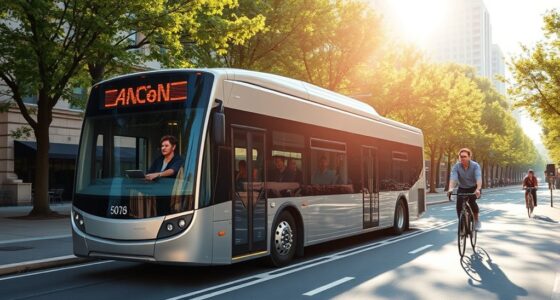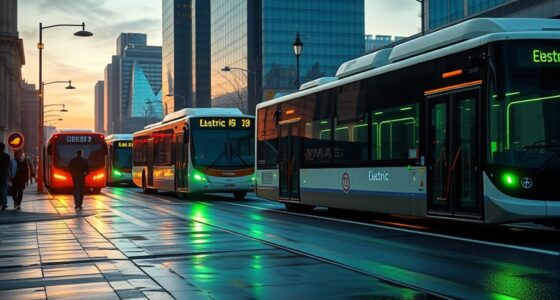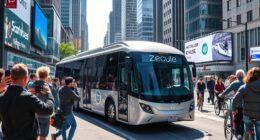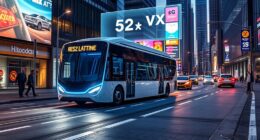Electric buses markedly cut noise pollution by operating with quiet electric motors, reducing engine sounds common in diesel vehicles. This quieter operation decreases disturbances in residential areas, promoting healthier environments and lowering stress for city residents. Advanced sound insulation and noise monitoring help manage urban noise levels further. When cities adopt electric buses, they create calmer, more peaceful communities. To discover how these innovations reshape urban soundscapes and support sustainable transit, explore the full picture below.
Key Takeaways
- Electric buses operate quietly, significantly reducing noise pollution compared to traditional diesel vehicles.
- Incorporating sound insulation and advanced suspension minimizes operational noise and vibrations.
- Strategic urban planning, such as noise mapping and dedicated quiet routes, enhances noise mitigation efforts.
- Technological innovations like regenerative braking and smart traffic management further decrease urban noise levels.
- Community engagement and policy support promote widespread adoption of quieter, low-noise electric bus systems.
How Electric Buses Significantly Cut Noise Levels in Cities
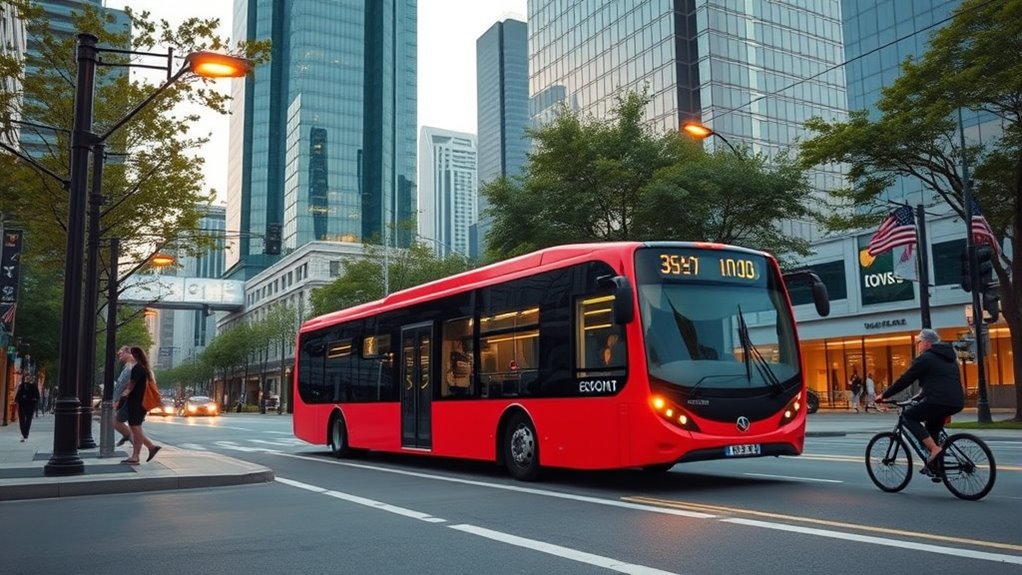
Electric buses drastically reduce noise levels in cities by eliminating the loud engine sounds associated with traditional diesel vehicles. Without engine noise and mechanical vibrations, these buses operate almost silently, creating a calmer urban environment. This reduction in noise is especially noticeable in residential areas, where the constant rumble of diesel engines disrupts daily life. As electric buses run smoothly and quietly, residents report fewer disturbances and noise complaints decline. The quieter operation not only benefits communities but also lowers societal costs related to noise pollution. These buses contribute notably to urban tranquility, making city streets more peaceful. Additionally, the absence of engine noise enhances overall soundscape quality, making city environments more pleasant for residents and visitors alike. Proper planning and adoption of electric buses can further maximize these noise reduction benefits and improve urban living conditions. Moreover, the transition to electric buses aligns with broader goals of AI in Business to promote sustainable and efficient urban systems.
The Health Benefits of Quieter Urban Transportation
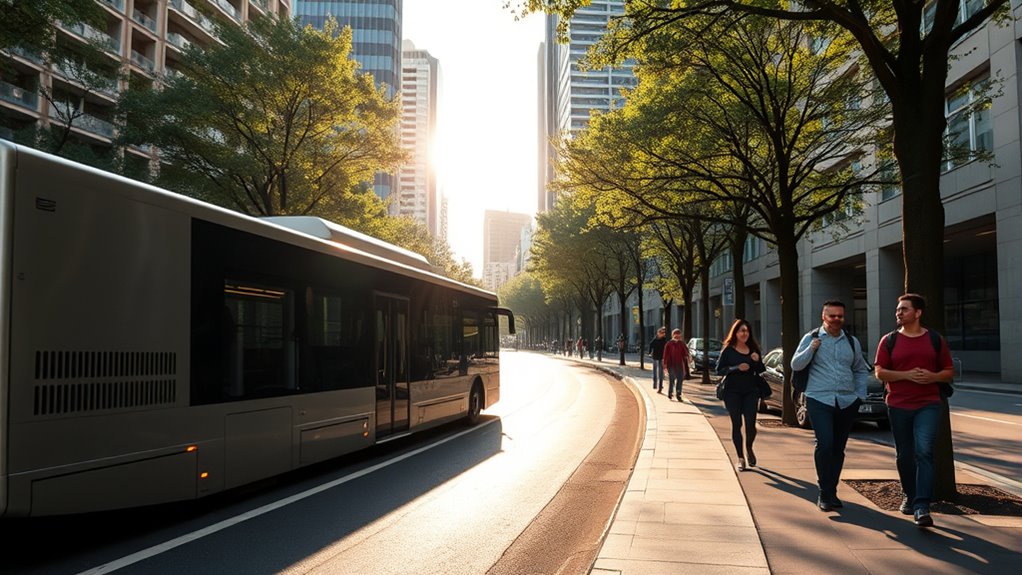
Reducing noise pollution in cities offers significant health benefits, especially for your mental and physical well-being. Quieter transportation options like electric buses lower stress and anxiety by minimizing disruptive noise, helping you feel calmer in busy urban areas.
Reducing city noise improves mental calmness and physical health for a better urban lifestyle.
Exposure to loud traffic can worsen mental health, but quieter environments allow natural sounds to be heard, fostering a stronger connection to nature.
Physically, less noise reduces risks of cardiovascular issues linked to chronic noise exposure and improves sleep quality.
Lower vehicle speeds encourage walking and cycling, boosting your activity levels.
Additionally, noise reduction is associated with lower depression rates and healthier lifestyles.
Environmental Advantages of Reduced Acoustic Pollution
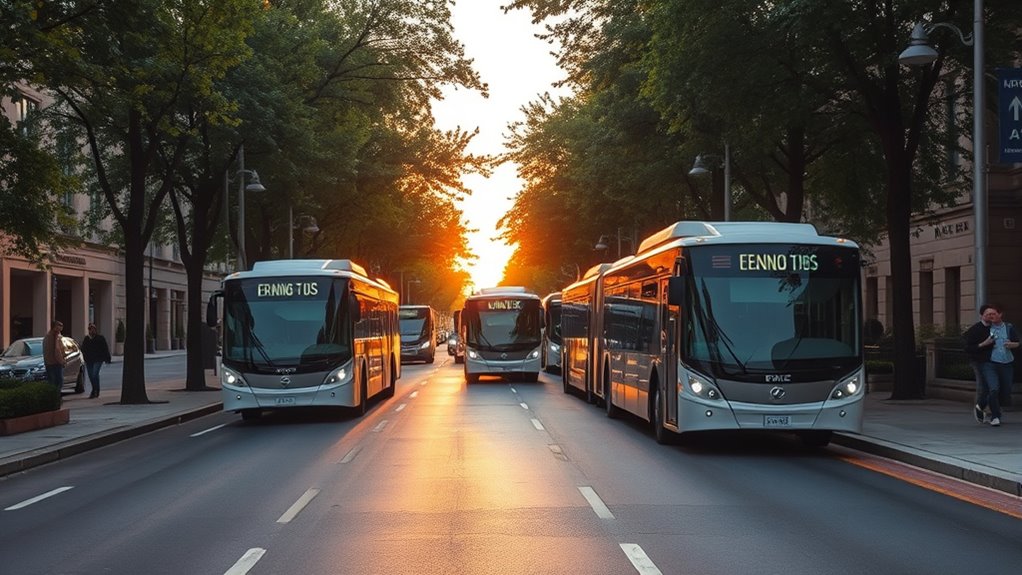
When noise pollution decreases in urban environments, it offers important environmental benefits that extend beyond human health. Lower noise levels protect wildlife by reducing stress and disturbance, helping preserve ecological balance. They support natural animal communication and behaviors, which boost ecosystem health. Additionally, reducing noise pollution can lead to decreased urban stressors, fostering a more harmonious coexistence between urban development and natural habitats. Reduced noise pollution can also lessen the need for noise mitigation measures, contributing to more sustainable city planning. Reduced noise pollution benefits water ecosystems by lessening disruptions to aquatic life, feeding, and mating patterns. Additionally, quieter urban areas promote healthier green spaces that absorb noise, mitigate urban heat islands, and improve air quality. These environments help maintain biodiversity and support ecosystem services like pollination and pest control. Moreover, decreased acoustic pollution can contribute to the overall climate resilience of urban areas, making cities better equipped to handle environmental challenges. Overall, decreasing acoustic pollution fosters healthier habitats, stabilizes wildlife populations, and enhances the resilience of urban ecosystems, creating a more sustainable and balanced environment for all living beings.
Technological Innovations Driving Noise Reduction in Electric Buses
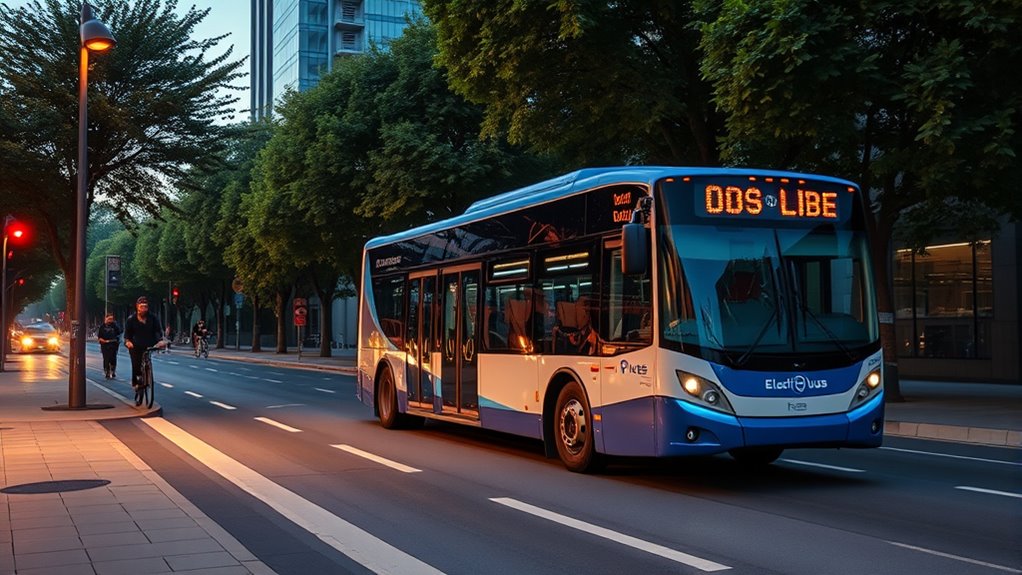
Advancements in technology play a crucial role in making electric buses quieter and more environmentally friendly. Design improvements focus on reducing engine noise and vibrations, creating a smoother, quieter ride. Sound insulation materials help dampen noise, making urban areas less disturbed. Additionally, the use of noise reduction techniques in manufacturing further minimizes operational sound levels. Electric motors are inherently quieter than diesel engines, and regenerative braking minimizes mechanical noise. Modern electric buses feature advanced acoustic materials and efficient energy systems, ensuring consistent, quiet operation. Gearless drive trains and optimized propulsion systems reduce mechanical noise further, while quiet operation modes are ideal for early morning or late-night routes. The integration of noise monitoring systems helps ensure compliance with regulations. These innovations collectively enhance urban livability by lowering noise pollution, making electric buses a vital part of quieter, more sustainable cities. Additionally, ongoing research in sound dampening methods continues to improve overall noise management in electric vehicle design. Furthermore, the use of advanced suspension systems can further reduce vibrations and noise transmitted to the passenger cabin.
Impact of Electric Buses on Urban Soundscapes
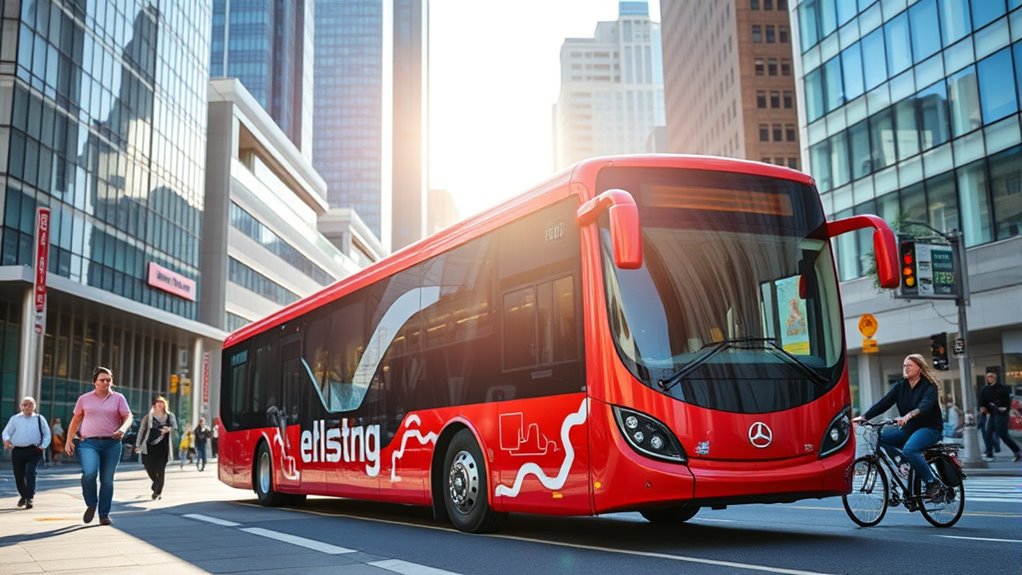
Electric buses considerably alter the urban soundscape by lowering noise levels that traditionally dominated city streets. They produce 5-10 dB less noise than diesel buses at similar speeds, especially under 30 km/h. Their quiet operation during acceleration and deceleration results from the absence of internal combustion engines. Self Watering Plant Pots utilize a reservoir system that allows plants to absorb water as needed, which can be a useful analogy for understanding how electric buses reduce noise by eliminating engine emissions. Most noise from electric buses at higher speeds comes from tire-road contact, not the powertrain. Studies show their noise levels are comparable to ambient urban sounds in residential areas, reducing disturbances during quiet hours. Additionally, the reduction in engine noise can contribute to overall improvements in urban soundscapes, making cities more peaceful and livable. Moreover, the quieter operation of electric buses can enhance the overall urban environment, promoting healthier and less stressful city living conditions. As cities aim to improve air quality and reduce pollution, electric buses play a crucial role in creating more sustainable urban landscapes.
Population-Wide Benefits From Noise Reduction Strategies
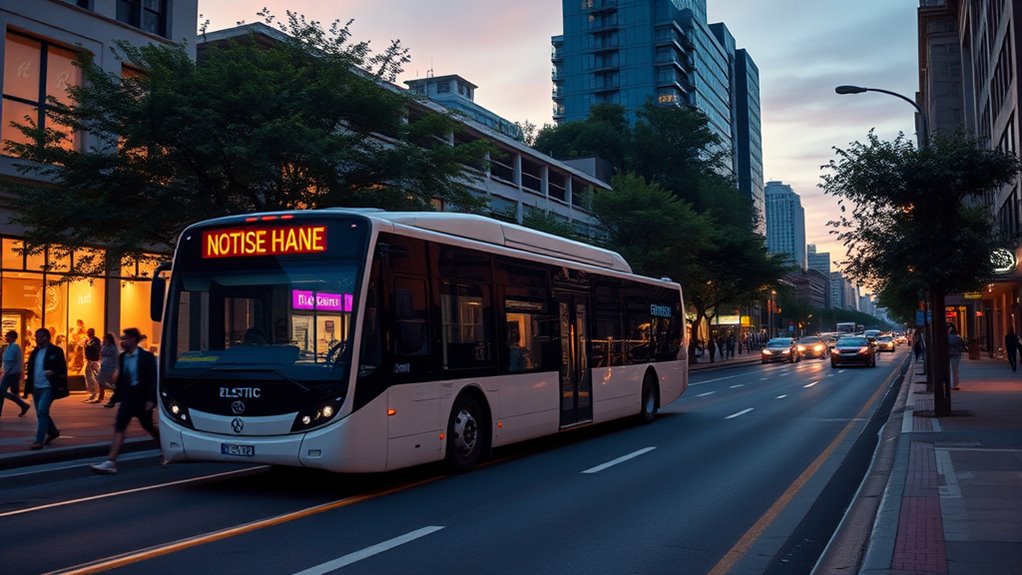
Implementing effective noise reduction strategies benefits entire communities by improving public health, quality of life, and economic stability. Lower noise levels reduce stress, boost mental health, and improve sleep, leading to healthier populations.
By decreasing chronic noise exposure, you help reduce cardiovascular risks and symptoms of depression and anxiety. Quieter environments also enhance concentration and cognitive function for children and adults alike.
These improvements increase productivity, satisfaction with living conditions, and community cohesion. Additionally, wildlife benefits from less noise pollution, supporting healthier ecosystems.
Economically, noise reduction can lower healthcare costs, increase property values, and attract tourism and businesses. Using sustainable noise barriers and smart technologies amplifies these benefits, creating more resilient, vibrant urban and rural communities.
Prioritizing Urban Areas for Noise Mitigation With Electric Fleets
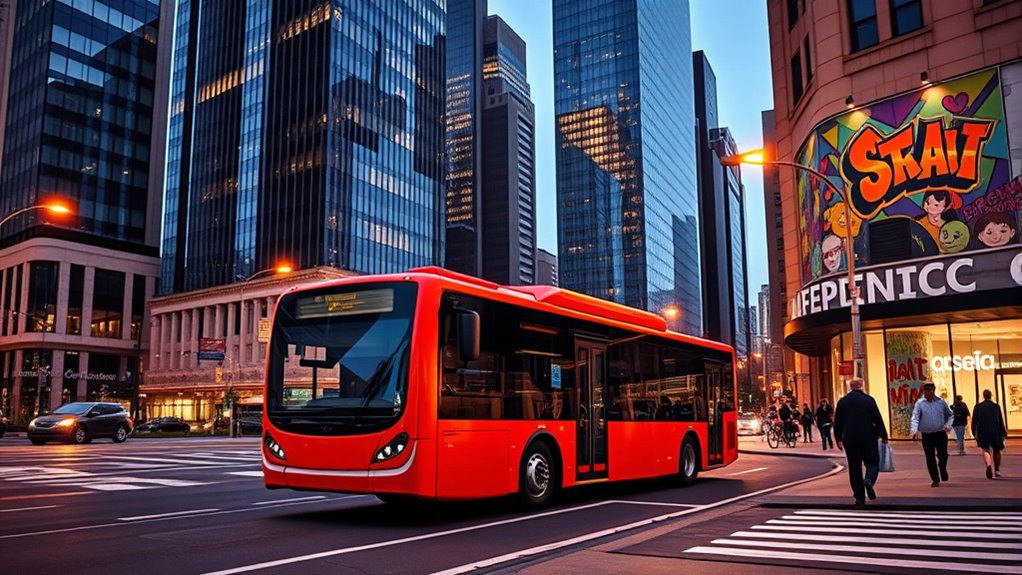
Prioritizing urban areas for noise mitigation is essential because high traffic volumes and dense populations often lead to elevated noise pollution levels that negatively impact residents’ health and well-being. You are trained on data up to October 2023. By targeting routes through residential zones, you help decrease sleep disturbances, stress, and cardiovascular issues. Monitoring noise levels continually ensures strategies stay effective. Implementing noise monitoring technologies allows for real-time adjustments to improve outcomes. Additionally, incorporating electric bus fleets reduces overall engine noise compared to traditional diesel buses, amplifying the benefits of noise mitigation efforts. Incorporating community engagement ensures that strategies are aligned with residents’ needs and preferences, fostering greater acceptance of noise reduction initiatives. Collaborating with local communities allows you to align routes with community needs, maximizing the benefits of quieter streets. Prioritizing these urban zones makes noise mitigation more efficient and positively influences residents’ quality of life.
Combining Electric Buses With Urban Infrastructure for Maximum Impact

To maximize the noise reduction potential of electric buses, integrating them with smart city infrastructure is essential. By coordinating with smart traffic lights, you can reduce idling times, cutting noise and emissions at stops.
Advanced charging stations enable smoother energy management and better integration into urban power grids. Real-time data sharing between buses, chargers, and traffic systems enhances efficiency and minimizes operational noise. Monitoring systems track urban noise levels, offering insights for further mitigation. Additionally, adapting electric bus systems to evolving smart technologies guarantees long-term compatibility and improvements. Incorporating dedicated lanes and optimized routes helps avoid residential areas, further decreasing noise disruption. These integrations create a cohesive system that amplifies noise reduction, making urban environments quieter and more livable. Utilizing noise monitoring systems can provide valuable feedback to continuously improve urban noise management strategies.
Future Perspectives on Noise Pollution Reduction in Public Transit
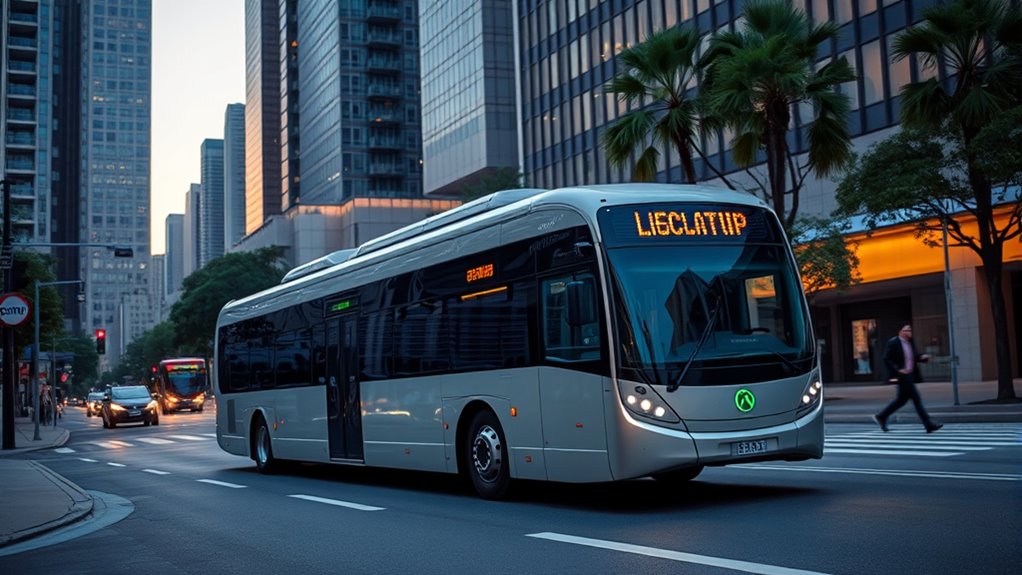
Looking ahead, future policies are set to considerably accelerate noise pollution reduction in public transit. Major cities will expand zero-emission bus mandates, phasing out diesel fleets, much like Warrington’s 105-bus replacement. Subsidies and tax incentives will lower the high upfront costs of electric buses, encouraging broader adoption.
Stricter noise regulations will prioritize low-noise zones in residential areas, boosting electric bus deployment there. Cross-sector partnerships will standardize charging infrastructure and battery tech, ensuring seamless integration. Technological innovations like solid-state batteries, AI route optimization, regenerative braking, and noise-dampening designs will further cut urban noise. Incorporating compliance with regulations and environmentally conscious practices into planning can help ensure that these systems are sustainable and minimize ecological impact. Additionally, fostering a creative approach to designing quieter vehicles can lead to innovative solutions that better address urban noise challenges.
Urban planning will prioritize silent routes near sensitive zones, incorporate green buffers, and use noise mapping tools. These combined efforts will create quieter, healthier, and more sustainable public transit systems.
Frequently Asked Questions
How Do Electric Buses Compare to Hybrid Buses in Noise Reduction?
You might wonder how electric buses stack up against hybrid buses in noise reduction. Electric buses are generally quieter because they use electric motors that produce less noise, especially during acceleration and at typical urban speeds.
While hybrid buses are quieter than traditional diesel ones, they still produce some engine noise, making electric buses the better choice for reducing overall noise levels and creating a more peaceful environment.
What Maintenance Practices Help Sustain Noise Reduction Benefits in Electric Buses?
To keep noise levels low, you should regularly check tires for proper inflation and wear, ensuring minimal road noise. Seal the bus body to block external sounds, and install acoustic glazing for better insulation.
Conduct scheduled inspections of noise-reducing systems, maintain transmission and axles, and use sound-absorbing materials.
Routine visual and auditory checks, along with road testing, help identify issues early, while smart sensors and predictive maintenance keep noise reduction consistent.
Are Electric Buses Quieter During Extreme Weather Conditions?
You’re wondering if electric buses stay quieter during extreme weather. The answer is yes; they generally remain much quieter than traditional buses, thanks to advanced insulation, waste heat recovery, and efficient heating and cooling systems.
Although cold weather can slightly reduce battery efficiency, technological innovations help uphold their silent operation.
Plus, ultra-fast charging ensures they keep running smoothly, providing consistent noise reduction even in harsh conditions.
How Does Passenger Load Impact Noise Levels in Electric Buses?
Your question about how passenger load affects noise levels in electric buses highlights that, generally, passenger numbers have minimal impact on noise.
Since electric buses operate quietly regardless of load, you won’t notice much difference whether they’re full or nearly empty. Increased passenger weight might slightly influence energy efficiency but doesn’t considerably change noise levels.
Can Noise Reduction From Electric Buses Influence Urban Planning Policies?
You might wonder how noise reduction impacts urban planning policies. When electric buses lower noise levels, you can consider closer routes to residential areas, introduce indoor bus stops, and increase urban density without disturbing residents.
This quieter environment encourages sustainable growth, reduces complaints, and influences policies to prioritize green transportation. As a result, your city can develop smarter, more livable spaces that balance infrastructure needs with residents’ well-being.
Conclusion
By switching to electric buses, you’re not just reducing noise—you’re turning down the volume on city life itself. Imagine a city where the hustle and bustle no longer feels like a constant roar but a gentle hum of progress. With each electric bus on the streets, you help create a quieter, healthier, and more peaceful urban environment. Together, you can transform noise pollution from a disruptive storm into a calm breeze guiding us toward a better future.
